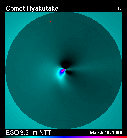NTT Observations of Comet Hyakutake (March 20, 1996)
Read More:

Dust Jets (ESO NTT Image)
Observations of Comet Hyakutake were performed with the ESO 3.5-m New Technology Telescope and the SUSI CCD high-resolution camera during the night March 19 - 20, 1996. A total of about 45 3-sec R-frames were obtained over a time interval of 90 minutes. They will serve to continue the documentation of rapid changes in the near-nucleus environment, first found during last night's observations with the same instrumentation, cf. ESO Press Photo 25/96 (19 March 1996) .
During the beginning of this night, the weather at La Silla was not optimal; there were clouds and the seeing (a measure of the atmospheric turbulence) was mediocre and quite variable. However, by good luck, a period of exceptionally good seeing conditions was encountered, just before the observations of Comet Hyakutake started at 06:15 UT. Most of the CCD frames were obtained with a seeing better than about 0.6 arcsec, quite a few around 0.5 arcsec, and the very best at 0.39 arcsec.
At the moment of these observations, Comet Hyakutake was 0.194 AU (29.0 million km) from the Earth, and 1.146 AU (171.3 million km) from the Sun. At this distance from the Earth, 1 arcsec corresponds to 141 km, i.e. the frames with 0.40 arcsec resolution would allow to perceive objects as small as 56 km near the comet. The pixel size of the SuSI camera is 0.128 arcsec, corresponding to 18 km only.
It is therefore of particular interest to see whether any light can be detected from the cometary nucleus on the best NTT frames. Its diameter has so far been estimated at around 10 km (as that of Halley), and we would not expect to see it optically resolved (as an extended object). Nevertheless, an analysis of the distribution of light in the innermost 100 - 200 km of the surrounding gas and dust coma may still give some new information about the nucleus and its immediate environment.
We found that the central peak of light of the best frames has a diameter (Full Width Half Maximum or FWHM) of 0.64 arcsec (90 km), i.e. it is wider than the image resolution (0.40 arcsec). For this reason, we conclude that it is `resolved' on these images, and that we see it as an extended object, not just as a point of light. Removing the contribution of the seeing leaves about 0.50 arcsec (70 km). This is therefore the real diameter of the dense, central condensation of dust (and gas) around the nucleus.
In this provisional analysis, we find no excess light from the nucleus itself. From this we conclude that the nucleus is significantly smaller than 70 km and that most probably it is completely embedded in the surrounding dust.
Olivier Hainaut (Institute of Astronomy, Honolulu, Hawaii) and Richard West (ESO)